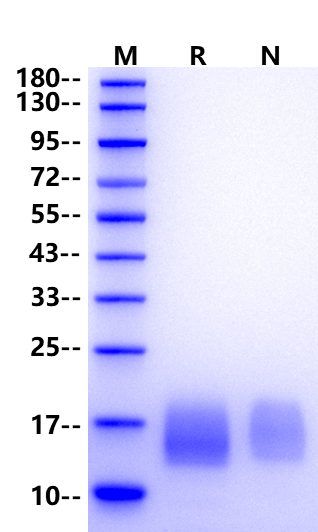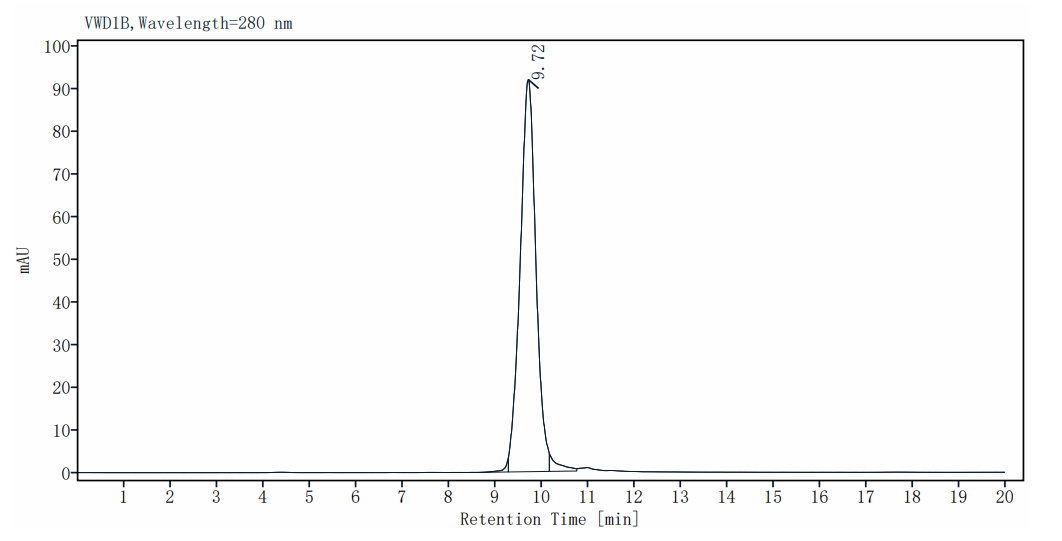Met1-Ala54, with C-terminal 8*His MLQMAGQCSQNEYFDSLLHACIPCQLRCSSNTPPLTCQRYCNASVTNSVKGTNAGGGSHHHHHHHH
15-19kDa (Reducing)
>95% by SDS-PAGE
PBS, pH7.4
Reconstitute at 0.1-1 mg/ml according to the size in ultrapure water after rapid centrifugation.
· 12 months from date of receipt, lyophilized powder stored at -20 to -80℃.
· 3 months, -20 to -80℃ under sterile conditions after reconstitution.
· 1 week, 2 to 8℃ under sterile conditions after reconstitution.
· Please avoid repeated freeze-thaw cycles.
BCMA (The B-cell maturation antigen), also designated as TNFRSF17, belongs to the tumor necrosis factor receptor superfamily, which is a family of cytokine receptors. BCMA is encoded by a 2.92-kb TNFRSF17 gene located on the short arm of chromosome 16 (16p13.13) and composed of 3 exons separated by 2 introns. There are four natural splice variants of human BCMA that present with different receptor binding affinities, membrane-anchoring ability, and intracellular domain signaling. BCMA main ligands are the cytokines B-cell activating factor and a proliferation-inducing ligand. The interaction between BCMA and its ligands activates the NF-κB signaling pathway that plays an important role in B-cell proliferation and maturation and is essential for the survival of long-lived bone marrow plasma cells. BCMA is expressed preferentially on mature B cells and has minimal expression on hematopoietic stem cells or other cell types. The BCMA has emerged as a central target in multiple myeloma (MM). In preclinical studies, overexpression of BCMA and the interaction with is ligand, a proliferation-inducing ligand (APRIL), was found to promote MM progression in vivo and augment MM cell growth and survival through induction of multiple signaling cascades, including protein kinase B (AKT), MAPK, and nuclear factor (NF)-κB. Additionally, BCMA has been shown to be solubilized at high levels in serum of patients with MM (sBCMA). This form of sBCMA binds to B-cell activating factor (BAFF). The role of BAFF is to stimulate normal B-cell and plasma cell development; however, this functioning is prevented when it is bound by BCMA in the serum, thereby leading to decreased polyclonal immunoglobulin levels in patients with MM.


2e5 of transient transfected anti-BCMA ScFv CAR-293 cells were stained with 0.1ug BCMA His Tag Protein, Human, (Cat. No. UA010083) and unlable respectively (Fig. C and B), and non-transfected 293 cells were used as a control (Fig. A). Alexa Fluor 647 signal was used to evaluate the binding activity. 2e5 of transient transfected anti- BCMA ScFv CAR-293 cells were stained with competitor respectively (Fig.D). APC signal was used to evaluate the binding activity.
2e5 of transient transfected anti- BCMA ScFv CAR-293 cells were stained with isotype and Whitlow/218 Linker-Alexa Fluor® 488 (Fig. E and F). Alexa Fluor® 488 signal was used to evaluate the binding activity.


The purity of BCMA/TNFRSF17 His Tag Protein, Human is greater than 95% as determined by SEC-HPLC.

Immobilized BCMA/TNFRSF17 His Tag Protein, Human (Cat. No. UA010083) at 2.0μg/mL (100μL/well) can bind Anti-Human BCMA (Belantamab) with EC50 of 0.68-0.88ng/mL.

Immobilized BCMA/TNFRSF17 His Tag Protein, Human (Cat. No. UA010083) at 2.0μg/mL (100μL/well) can bind Anti-Human BCMA (Belantamab), LotA with EC50 of 1.00-1.55ng/mL. LotB with EC50 of 1.15-1.66ng/mL.